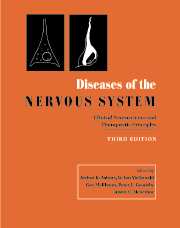Book contents
- Frontmatter
- Dedication
- Contents
- List of contributors
- Editor's preface
- PART I INTRODUCTION AND GENERAL PRINCIPLES
- 1 Pathophysiology of nervous system diseases
- 2 Genetics of common neurological disorders
- 3 Repeat expansion and neurological disease
- 4 Cell birth and cell death in the central nervous system
- 5 Neuroprotection in cerebral ischemia
- 6 Promoting recovery of neurological function
- 7 Measurement of neurological outcomes
- 8 Principles of clinical neuro-epidemiology
- 9 Principles of therapeutics
- 10 Windows on the working brain: functional imaging
- 11 Windows on the working brain: magnetic resonance spectroscopy
- 12 Windows on the working brain: evoked potentials, magnetencephalography and depth recording
- PART II DISORDERS OF HIGHER FUNCTION
- PART III DISORDERS OF MOTOR CONTROL
- PART IV DISORDERS OF THE SPECIAL SENSES
- PART V DISORDERS OF SPINE AND SPINAL CORD
- PART VI DISORDERS OF BODY FUNCTION
- PART VII HEADACHE AND PAIN
- PART VIII NEUROMUSCULAR DISORDERS
- PART IX EPILEPSY
- PART X CEREBROVASCULAR DISORDERS
- PART XI NEOPLASTIC DISORDERS
- PART XII AUTOIMMUNE DISORDERS
- PART XIII DISORDERS OF MYELIN
- PART XIV INFECTIONS
- PART XV TRAUMA AND TOXIC DISORDERS
- PART XVI DEGENERATIVE DISORDERS
- PART XVII NEUROLOGICAL MANIFESTATIONS OF SYSTEMIC CONDITIONS
- Complete two-volume index
- Plate Section
12 - Windows on the working brain: evoked potentials, magnetencephalography and depth recording
from PART I - INTRODUCTION AND GENERAL PRINCIPLES
Published online by Cambridge University Press: 05 August 2016
- Frontmatter
- Dedication
- Contents
- List of contributors
- Editor's preface
- PART I INTRODUCTION AND GENERAL PRINCIPLES
- 1 Pathophysiology of nervous system diseases
- 2 Genetics of common neurological disorders
- 3 Repeat expansion and neurological disease
- 4 Cell birth and cell death in the central nervous system
- 5 Neuroprotection in cerebral ischemia
- 6 Promoting recovery of neurological function
- 7 Measurement of neurological outcomes
- 8 Principles of clinical neuro-epidemiology
- 9 Principles of therapeutics
- 10 Windows on the working brain: functional imaging
- 11 Windows on the working brain: magnetic resonance spectroscopy
- 12 Windows on the working brain: evoked potentials, magnetencephalography and depth recording
- PART II DISORDERS OF HIGHER FUNCTION
- PART III DISORDERS OF MOTOR CONTROL
- PART IV DISORDERS OF THE SPECIAL SENSES
- PART V DISORDERS OF SPINE AND SPINAL CORD
- PART VI DISORDERS OF BODY FUNCTION
- PART VII HEADACHE AND PAIN
- PART VIII NEUROMUSCULAR DISORDERS
- PART IX EPILEPSY
- PART X CEREBROVASCULAR DISORDERS
- PART XI NEOPLASTIC DISORDERS
- PART XII AUTOIMMUNE DISORDERS
- PART XIII DISORDERS OF MYELIN
- PART XIV INFECTIONS
- PART XV TRAUMA AND TOXIC DISORDERS
- PART XVI DEGENERATIVE DISORDERS
- PART XVII NEUROLOGICAL MANIFESTATIONS OF SYSTEMIC CONDITIONS
- Complete two-volume index
- Plate Section
Summary
A number of techniques have been developed for the study of human brain functions in normal and disordered states. Each of them monitors function from a selective point of view. Whereas functional imaging techniques are based on neurovascular coupling (functional magnetic resonance imaging (fMRI), positron emission tomography (PET), nearinfrared spectroscopy (NIRS) and optical imaging), electrophysiological methods directly reflect neuronal activity. Electroencephalography (EEG) and magnetencephalography (MEG) provide information about global as well as regional activity under stationary conditions or for evoked or event related responses. Subdural or epicortical recordings for the identification of epileptogenic foci and microelectrode recordings for functional target identification during stereotactic neurosurgery complement the spectrum of the clinical application of neurophysiological tools.
Taken together, the neurovascular and neurophysiological methods provide largely complementary information that allows better insights in normal and disturbed brain function. The superimposition of MEG data on MR images combines the high spatial and temporal resolution of the respective methods. EEG recordings can now be conducted inside the MR scanner allowing the recognition of epileptogenic foci during EEG-defined seizure episodes.
Towards an integrative MEG and EEG study of cognitive brain functions
EEG and MEG measures arise from the same cortical source, namely from ordered intracellular currents in the pyramidal cells (Okada, 1982). Since the pyramidal cells in a circumscribed area show basically the same orientation orthogonal to the surface, the superimposed neural currents may result in macroscopically measurable electromagnetic fields. The electric and magnetic fields have orthogonal orientation and bear formally equivalent information; however, it may well be that stimulus-triggered event related potentials (ERPs) or magnetic fields (MFs) reveal different aspects of the underlying neural sources depending, for example on the nature of the task and the anatomy of the cortical region of interest. For several reasons, source estimation based on MFs is often superior to ERP based fits. First, opposite to electrical currents MF remain almost unchanged when passing through anatomical structures between the cortex and the sensor sets. Hence, the MFs are less susceptible to inadequate head models, both regarding anatomical shape and tissue conductivities (CSF space, scull, scalp). Secondly, the superficially observed MF originate from the primary neuronal currents (i.e. currents inside the dendrites) whereas volume currents do not contribute for physical reasons. In contrast, ERPs reflect both primary and volume currents.
- Type
- Chapter
- Information
- Diseases of the Nervous SystemClinical Neuroscience and Therapeutic Principles, pp. 160 - 174Publisher: Cambridge University PressPrint publication year: 2002

